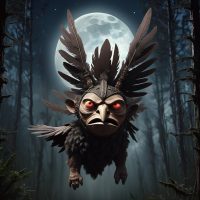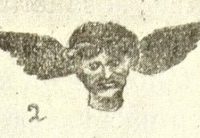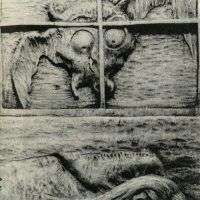Chonchon : The Flying Head
Listen
At a glance
| Description | |
|---|---|
| Origin | Mapuche Mythology |
| Classification | Spirits |
| Family Members | N/A |
| Region | Chile, Argentina |
| Associated With | Magic, Sorcery, Flight, Invisibility, Blood Consumption |
Chonchon
Introduction
The Chonchon is one of the most sinister and fascinating figures in Mapuche mythology, haunting the folklore of Chile and Argentina for centuries. Described as a supernatural being created through sorcery, the Chonchon is not a naturally occurring creature but the transformation of a powerful witch or sorcerer, known as a kalku, who deliberately detaches their head and sends it flying into the night. With its unsettling appearance and eerie cry, the Chonchon has long symbolized forbidden power, fear of witchcraft, and the consequences of misusing hidden knowledge. Unlike simple ghost tales, its story is deeply tied to the Mapuche worldview, where spiritual balance was essential to survival, and any disruption through dark practices carried grave consequences.
Physical Traits
The Chonchon is most often portrayed as a grotesque flying head, stripped of its body yet imbued with bird-like features. The most striking detail is its oversized ears, which sprout feathers and transform into wings, granting it the ability to glide through the night skies. In many stories, it also bears talons, sharp teeth, and a wild mane of feathers, enhancing its monstrous appearance. The Chonchon’s flight is accompanied by a chilling cry—“tue, tue, tue”—which villagers immediately recognize as a warning of misfortune or death.
Though invisible to most ordinary people, some traditions maintain that those with magical knowledge or spiritual sensitivity can see the Chonchon in its terrifying form. Whether appearing as a severed human head with wings or a birdlike shadow, its presence always instills dread. The combination of human and animal traits reinforces its identity as an unnatural being—something once human but corrupted through dark sorcery.
Family
Unlike many mythological creatures that belong to legendary bloodlines or divine families, the Chonchon’s origins are rooted in human choice. It is created when a kalku undergoes a forbidden transformation ritual, often by applying a magical ointment or reciting powerful incantations that detach the head from the body. Once free, the head mutates into the Chonchon, taking flight while the sorcerer’s body remains hidden.
Legends often suggest that this transformation was not performed alone. Some accounts describe covens of kalkus who gathered at night to share knowledge, summon spirits, and send their Chonchons into the world. In these gatherings, a strange kind of family-like bond could be formed, not through blood, but through shared allegiance to malevolent powers. In other versions, the Chonchon is aided by wekufe, dark spirits who strengthen its sorcery and tether it to a greater network of magical forces. Thus, the Chonchon does not have a traditional family but instead belongs to the shadowy kinship of witches and spirits.
Other names
The Chonchon goes by several names across different regions and traditions. Perhaps the most common alternative is Tue-Tué, a direct reference to its unmistakable cry. In some oral tales, people call it Chucho, Chuchu, or Kijkij, all variations with onomatopoeic qualities that mimic its eerie sounds. The term Chonchonyi has also been recorded, particularly in rural folklore.
These variations highlight the creature’s reach across South American storytelling, with its legend adapting slightly to different communities. Comparisons have also been drawn to other global mythological beings, such as the Penanggalan of Malaysia, the Manananggal of the Philippines, and Japan’s Rokurokubi—all entities involving flying heads or disembodied transformations. Despite these similarities, the Chonchon remains distinct in its cultural role as a feared messenger of death within the Mapuche tradition.
Powers and Abilities
The Chonchon’s powers stem from its origin as the manifestation of a sorcerer’s darkest abilities. Its most well-known power is flight, achieved through its wing-like ears. Unlike natural birds, it moves silently and invisibly to most, making its arrival almost impossible to predict except by its cry.
Another feared attribute is its vampiric nature. Like the blood-drinking beings of other cultures, the Chonchon is said to feed on the life force or blood of the sick, weak, or sleeping, leaving victims drained or even dead. This parasitic behavior associates it with illness and sudden, unexplained deaths in villages.
The Chonchon also inherits the full range of sorcerous powers of the kalku. This includes casting curses, spreading disease, and summoning spirits to aid in mischief or destruction. In some stories, it can shape-shift back into its human form after its nightly flights, seamlessly resuming the life of a villager by day while terrorizing communities by night.
The most chilling ability, however, lies not in physical attack but in symbolism. Its cry is universally feared as an omen of death. Hearing “tue, tue, tue” near a household often meant someone within was destined to die soon. Communities developed chants and protective rituals to drive it away, reinforcing the belief in its connection to mortality and misfortune.
Modern Day Influence
Despite its roots in pre-Columbian mythology, the Chonchon has not faded into obscurity. In Chile and Argentina, it continues to be a key figure in oral storytelling, often used by parents to warn children against wandering at night or dabbling in forbidden practices. The fear of its cry remains strong in some rural areas, where strange bird calls are sometimes interpreted as signs of bad luck.
In academic circles, the Chonchon is studied as part of the broader Mapuche system of belief, especially in relation to sorcery, shamanic transformation, and social control. Anthropologists note that stories of the Chonchon serve as cautionary tales, warning against ambition, misuse of power, and betrayal of communal balance.
The Chonchon also thrives in popular culture. Writers and filmmakers across South America have adapted its legend for horror novels, short stories, and even film scripts, using it as a symbol of indigenous mystery and terror. Bestiaries of mythical creatures frequently list the Chonchon alongside global legends of flying heads, expanding its influence to international audiences. In online culture and fantasy gaming communities, it occasionally appears as inspiration for monstrous creatures, demonstrating its adaptability in creative reimaginings.
For the Mapuche, however, the Chonchon is not simply a creature of entertainment. It represents an enduring aspect of their spiritual heritage, a reminder of the constant tension between good and evil forces, and the dangerous allure of unchecked power. Its place in both myth and modern storytelling highlights its resilience as a cultural icon that bridges the past and present.
Related Images
Source
Contreras, C. (2000). Unidad temática y variedad textual: un tópico social en tres relatos orales. Estudios Filológicos, 35.
Urban Legends Debunked. (2024, September 26). Chonchon: Unraveling the Mysterious Origins of the Chilean Flying Head Legend. https://www.urbanlegendsdebunked.com/stream/chonchon/
Fabulahub. (2025, August 31). Legend of the Chonchon – Mapuche Folklore from Chile. https://fabulahub.com/en/story/legend-of-the-chonchon-chile-mapuche/sid-2295
Chonchon. (2006, October 31). In Wikipedia. https://en.wikipedia.org/wiki/Chonchon
Chonchon. (2023, March 9). In Wikipedia Nucleos. https://wikipedia.nucleos.com/viewer/wikipedia_en_all/A/Chonchon
Unsolved: Chonchon. (2024, February 3). HandWiki. https://handwiki.org/wiki/Unsolved:Chonchon
Chon-chon | WikiBestiary. (2007, December 31). https://monsters.fandom.com/wiki/Chon-chon
A Book of Creatures. (2015, October 18). Chonchón. https://abookofcreatures.com/2015/10/19/chonchon/
Frequently Asked Questions
What is lorem Ipsum?
I am text block. Click edit button to change this text. Lorem ipsum dolor sit amet, consectetur adipiscing elit. Ut elit tellus, luctus nec ullamcorper mattis, pulvinar dapibus leo.
What is lorem Ipsum?
I am text block. Click edit button to change this text. Lorem ipsum dolor sit amet, consectetur adipiscing elit. Ut elit tellus, luctus nec ullamcorper mattis, pulvinar dapibus leo.
What is lorem Ipsum?
I am text block. Click edit button to change this text. Lorem ipsum dolor sit amet, consectetur adipiscing elit. Ut elit tellus, luctus nec ullamcorper mattis, pulvinar dapibus leo.
What is lorem Ipsum?
I am text block. Click edit button to change this text. Lorem ipsum dolor sit amet, consectetur adipiscing elit. Ut elit tellus, luctus nec ullamcorper mattis, pulvinar dapibus leo.
What is lorem Ipsum?
I am text block. Click edit button to change this text. Lorem ipsum dolor sit amet, consectetur adipiscing elit. Ut elit tellus, luctus nec ullamcorper mattis, pulvinar dapibus leo.








